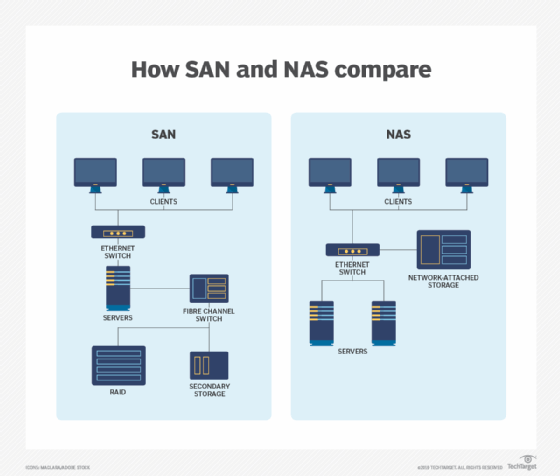primary storage (main storage)
What is primary storage?
Primary storage is the collective methods and technologies that capture and retain digital information in active use and critical for an organization's operations. Users, applications and other hardware systems frequently access primary storage data.
In contrast, secondary storage is for data that is less frequently accessed, or no longer accessed at all. Examples of secondary storage include devices or systems to store backup data and archival data that is rarely accessed. Since secondary data has limited immediate usefulness and is infrequently accessed, it is often referred to as data at rest.
Primary and secondary storage are components of a tiered-storage architecture that comprises at least two primary and secondary levels of storage, although some environments have additional storage tiers. Regardless of the number of storage tiers, the primary tier is typically reserved for transactional data or mission-critical application data that requires high performance.
Types of primary storage
Depending on the computing environment, primary storage might consist of hard disks or flash-based solid-state drives installed locally on an application server or file server. Alternatively, the primary storage tier might be a centralized and shared storage-area network (SAN) or network-attached storage (NAS) array. It's how the storage resource is used rather than the type of storage architecture that determines if it is primary storage or some other tier of data storage.
If an organization's primary storage is used for high-transaction, random access applications such as database management systems, the tier will often be a SAN device (or set of devices). SAN systems are block oriented, which means they store and access data in chunks of a predetermined size. Block access operates similarly to the way the storage media stores, catalogs and accesses the data it hosts, so it typically provides the high performance that database systems require.
A NAS array may also be used as primary storage, but it uses a different method of storing and accessing data than a SAN. NAS storage is also often referred to as file storage, as it overlays the storage media system with a directory and metadata that more closely aligns with how applications store their related data.
Applications such as Microsoft Word or Excel find their documents or spreadsheets via the NAS directory that collects various pieces of a file that might be scattered across a drive or multiple drives. It presents the file to the application as a single unit. Because of this added layer, file-based systems like NAS tend to be slower than SANs, but if a NAS meets an organization's requirements for primary storage, it can certainly function at that level.

Cloud-based storage can also serve as primary storage, but because it is remote, the circumstances under which it would be used as a primary storage resource are different from those related to SAN or NAS. If an application is locally hosted in an organization's data center, it will have to access its store in a cloud service via a private or public network such as the internet.
Types of media used for primary storage
A primary storage system, whether local in a server, networked and shared like a SAN or NAS, or cloud-based, may be composed of various types of media. Hard-disk media is still the most prevalent type of data storage, but because high performance is typically required of primary storage, solid-state drives (SSDs) are increasingly replacing hard disks.
In some cases, primary storage systems may employ both types of storage media, using solid-state devices for fast access and processing of data as well as hard-disk drives for mass storage of the required data.
A more recent development in storage technology, storage-class memory, may also be used for primary storage if performance demands are particularly rigorous. Storage class memory combines some of the features of solid-state storage with those of RAM, which works closely with a server's central processing unit (CPU) to feed data to an application as rapidly as possible.
Unlike RAM, storage class memory is persistent, which means it retains data even when power is cut off. And while storage class memory is somewhat slower than RAM, it's much faster than standard solid-state drives, which makes it ideal for use as primary storage for applications such as in-memory databases. It's also considerably more expensive than conventional solid-state storage.
Legacy references of primary storage
Back when mainframe computers ruled the data center, the term primary storage often referred to the volatile memory in the computer -- much like RAM in modern servers -- rather than the media that provided a permanent, persistent home for the data that might have been called secondary storage at that time.
That storage would have ranged from the earliest punch card technologies to tape to hard disk drives.
Editor's note: This article was revised in 2024 by TechTarget editors to improve the reader experience.








